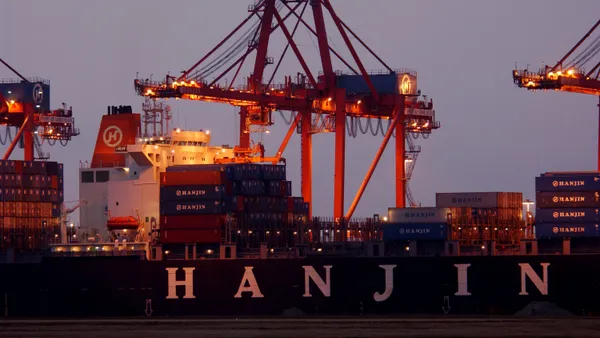Dive Brief:
- Google is committing to carbon-neutral shipping "to and from customers" by 2020 and and to recycled materials in 100% of its products by 2022, according to a company blog post.
- The tech giant plans to achieve this by increasing the amount of hardware shipped via ocean freight (as opposed to air freight), which has already brought per-unit emissions down by 40% between 2017 and 2018, and by purchasing carbon credits from third parties, according to a Reuters report.
- Google has been carbon neutral since 2007, though this did not include its external shipping and logistics functions, according to the company's 2018 Environmental Report. Julie Van Vliet, a communications officer in Google's hardware division, told Supply Chain Dive "we buy carbon offsets for any remaining emissions we haven’t yet eliminated. As per industry practice, our carbon neutrality commitment includes only operational emissions." This means that emissions from business travel, suppliers or shipping partners originally fell outside the scope of Google's 2007 commitment.
Dive Insight:
Between its digital and hardware-focused lines of business, Google uses a significant amount of energy to power and cool massive server farms and mass-produce phones, laptops and tablets. However, the company has made a point of reassuring customers that it is committed to environmental and energy sustainability despite its consumption.
Google has achieved its carbon neutrality goals to date "through an internal focus on reducing energy consumption and offsetting 100% of the electricity consumption of our operations with purchases of renewable energy," Vliet said. "We invest in high-quality, third-party-verified offsets, including landfill gas projects and animal waste management systems."
In a company blog post, Google said it has "partnered with more than 40 carbon offset projects to offset more than 16 million metric tons of carbon dioxide equivalent (tCO2e)" since 2007.
Google's switch to ocean shipping marks progress as ocean freight is far less carbon-intensive than air freight, emitting between 3.0 and 7.84 grams per ton-km of carbon compared to 435 for air, according to data from the World Shipping Council. In addition, the maritime shipping industry is pushing for more environmentally conscious operations to reduce emissions and maritime pollution. As a result, Google will be able to spend far less on carbon offsets to neutralize the environmental impact of shipping its hardware.
Other major firms have switched shipping modes to reduce their supply chains' carbon footprint as well. L'Oreal has committed to reducing its transportation emissions by 35% by 2030. In addition to reducing SKUs and taking other measures, the company found 1% of product weight shipped accounted for 30% of emissions in its distribution network, with air freight a significant contributor. As a result, the company has been upgrading emissions standards for its shipping partners and transferring more freight to ocean and rail shipping modes.
Google's direct competitors in the technology space have also been in the sustainability race with commitments of their own.
Apple announced in its most recent environmental report that it achieved its 100% renewable energy goal, has energy sustainability commitments from 40 suppliers and has reduced its overall carbon footprint by 35% since 2015. According to the report, Apple is directly sourcing renewable energy for its facilities and is working to ensure its supply chain partners do the same, as opposed to pursuing a carbon-credit purchase model. Additionally, the company has been using, and is looking to increase, the amount of recycled material used in its products while making them more energy efficient.
Microsoft has made similar commitments, more in line with Google's methods. According to the sustainability section of its website, the company instituted an "internal carbon fee" that has allowed it to operate 100% carbon neutral since 2012. This only includes its direct operations and offices, as opposed to its extended supply chain, although the company notes it "works with suppliers" to encourage them to reduce their emissions. As of 2017, the company has set a goal to reduce operational carbon emissions by 75% by 2030 against a 2013 baseline.














